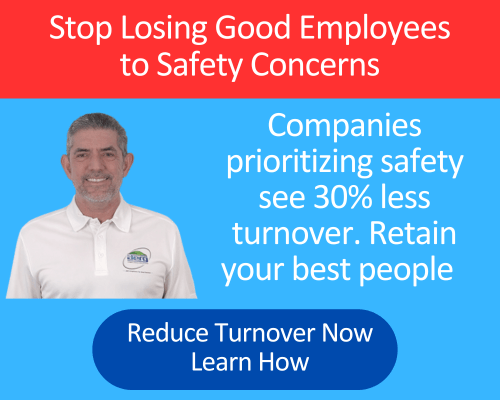Manufacturers Who Invest in Safety See Significantly Reduced Employee Turnover and Improved Retention
Introduction
Employee turnover continues to plague manufacturing facilities across the country, creating operational disruptions and escalating recruitment costs. However, forward-thinking manufacturers are discovering that safety excellence programs serve as powerful retention tools, dramatically reducing workforce turnover while enhancing operational efficiency. At Berg Compliance Solutions, our experience working with hundreds of manufacturing companies since 2003 has shown that comprehensive safety programs create workplace environments where employees feel valued and protected. When workers witness genuine commitment to their well-being through robust OSHA compliance training and environmental health safety programs, they develop stronger loyalty to their employers. This connection between safety excellence and employee retention isn’t coincidental—it reflects fundamental human psychology where people naturally gravitate toward secure, supportive work environments. Manufacturing leaders who prioritize safety excellence through proper OSHA 1910/1926 standards implementation and EPA/TCEQ regulatory expertise create competitive advantages in today’s challenging labor market.
Understanding the Connection Between Safety and Retention
Safety excellence directly impacts employee retention through multiple psychological and practical mechanisms. Workers who feel physically secure in their environment develop stronger emotional connections to their workplace, viewing their employer as genuinely caring about their welfare. This perception translates into increased job satisfaction and reduced likelihood of seeking alternative employment opportunities.
Manufacturing environments present significant health and safety hazards, making safety protocols crucial for worker confidence. When companies implement and maintain rigorous safety standards, employees experience reduced stress levels and improved morale. The psychological comfort of knowing proper safety measures are in place allows workers to focus on productivity rather than worrying about potential injuries.
Furthermore, safety excellence demonstrates organizational competence and professionalism. Employees prefer working for companies that exhibit strong leadership and operational excellence, viewing safety programs as indicators of overall management quality. This perception enhances employee pride and loyalty, contributing significantly to retention rates.
| Safety Factor | Impact on Retention | Employee Benefit |
|---|---|---|
| Hazard Prevention | High | Reduced injury risk |
| Safety Training | Medium | Skill development |
| Leadership Commitment | High | Trust building |
The Financial Impact of Safety-Driven Retention
Manufacturing companies implementing safety excellence programs experience substantial cost savings through reduced turnover expenses. Recruitment, training, and onboarding costs for replacement workers can be significant, particularly for skilled manufacturing positions requiring specialized knowledge and experience.
Beyond direct replacement costs, high turnover disrupts production schedules, affects team dynamics, and reduces overall operational efficiency. Experienced workers leaving take valuable institutional knowledge with them, creating knowledge gaps that impact productivity and quality standards.
Safety-focused retention strategies also reduce workers’ compensation claims and associated insurance premiums. Companies with strong safety records often qualify for reduced insurance rates, creating additional financial benefits beyond retention savings.
The cumulative effect of these savings can be substantial for manufacturing operations. Companies investing in comprehensive safety programs often find that retention improvements alone justify the program costs, with additional benefits from reduced injuries and improved productivity providing extra value.
| Cost Category | Traditional Approach | Safety Excellence Approach |
|---|---|---|
| Turnover Costs | High | Significantly Reduced |
| Training Expenses | Recurring | Minimized |
| Insurance Premiums | Standard Rates | Reduced Rates |
Building a Culture of Safety Excellence
Creating safety excellence requires more than implementing policies—it demands cultural transformation throughout the manufacturing organization. Leadership commitment must be visible and consistent, with managers actively participating in safety initiatives and demonstrating genuine concern for worker welfare.
Communication plays a crucial role in building safety culture. Regular safety committee meetings, open-door policies for reporting concerns, and transparent incident investigations help create environments where workers feel heard and valued. This communication fosters trust between management and employees, strengthening retention.
Recognition programs celebrating safety achievements reinforce positive behaviors and demonstrate organizational values. When companies acknowledge workers who contribute to safety improvements or maintain excellent safety records, they create positive reinforcement cycles that encourage continued engagement.
Training programs must be comprehensive and ongoing, ensuring workers understand both safety procedures and the reasoning behind them. Well-informed employees are more likely to follow safety protocols and appreciate their employer’s investment in their protection.
Implementing OSHA Compliance Training Programs
Effective OSHA compliance training serves dual purposes: meeting regulatory requirements and demonstrating employer commitment to worker safety. Comprehensive training programs covering OSHA 1910/1926 standards help workers understand their rights and responsibilities while building confidence in workplace safety measures.
Training should be tailored to specific manufacturing environments and job functions, ensuring relevance and practical application. Generic safety training often fails to resonate with workers, while job-specific programs demonstrate understanding of actual workplace hazards and challenges.
Regular refresher training keeps safety awareness high and addresses evolving workplace conditions. As manufacturing processes change or new equipment is introduced, corresponding safety training updates ensure workers remain protected and informed.
Documentation of training completion provides legal protection while demonstrating a systematic approach to safety management. Proper record-keeping supports regulatory compliance and shows commitment to continuous safety improvement.
In our experience at Berg Compliance Solutions, manufacturers who invest in comprehensive OSHA compliance training see notable improvements in both safety performance and employee satisfaction, directly contributing to enhanced retention rates.
Environmental Health Safety Programs That Retain Talent
Environmental health safety programs extend beyond basic injury prevention to address broader workplace wellness concerns. These comprehensive programs demonstrate holistic commitment to worker well-being, creating stronger emotional connections between employees and employers.
Air quality monitoring, noise control measures, and ergonomic assessments show attention to long-term health impacts rather than just immediate safety concerns. Workers appreciate employers who consider their future health and quality of life, not just current productivity requirements.
Chemical exposure management and proper ventilation systems protect workers from occupational illnesses while demonstrating sophisticated safety management. These measures require significant investment, signaling genuine commitment to worker protection rather than minimal compliance efforts.
Regular health screenings and wellness programs complement safety initiatives by addressing overall employee health. This comprehensive approach creates workplace environments where employees feel truly cared for, significantly impacting retention decisions.
| Program Component | Health Benefit | Retention Impact |
|---|---|---|
| Air Quality Control | Respiratory Health | High |
| Ergonomic Assessments | Musculoskeletal Health | Medium |
| Chemical Management | Long-term Wellness | High |
Texas Manufacturing Safety Compliance Advantages
Texas manufacturers face unique regulatory environments requiring specialized knowledge of both federal OSHA standards and state-specific requirements. Companies demonstrating expertise in navigating these complex regulations create competitive advantages in attracting and retaining skilled workers.
Austin’s growing manufacturing sector particularly benefits from comprehensive safety programs as competition for skilled workers intensifies. Companies with strong safety reputations find recruitment easier and retention rates higher than competitors with poor safety records.
EPA/TCEQ regulatory expertise becomes increasingly important as environmental regulations evolve. Manufacturers who stay ahead of regulatory changes and maintain excellent compliance records create stable work environments that workers prefer over uncertain situations at non-compliant facilities.
Local safety consulting partnerships provide ongoing support and expertise that internal resources might lack. Berg Compliance Solutions has helped hundreds of Texas manufacturers navigate these challenges, creating safer workplaces that naturally retain employees longer.
Measuring Safety Excellence Impact on Retention
Tracking retention improvements requires systematic data collection and analysis connecting safety initiatives to turnover rates. Baseline measurements before safety program implementation provide comparison points for evaluating effectiveness.
Exit interviews should specifically address safety concerns and perceptions to understand how safety factors influence departure decisions. This feedback helps refine safety programs and address specific retention challenges.
Employee satisfaction surveys including safety-related questions provide ongoing feedback about program effectiveness and areas needing improvement. Regular surveys help identify trends and potential issues before they impact retention.
Correlation analysis between safety metrics and retention rates helps quantify program value and justify continued investment. Companies can demonstrate return on investment through reduced turnover costs and improved operational stability.
Overcoming Implementation Challenges
Manufacturing companies often face resource constraints when implementing comprehensive safety programs. However, phased implementation approaches allow gradual program development while demonstrating early wins that build momentum and support.
Employee resistance to new safety procedures can be addressed through inclusive planning processes that involve workers in program development. When employees help design safety initiatives, they’re more likely to embrace and support implementation efforts.
Management commitment must be consistent and visible throughout implementation phases. Mixed messages or inconsistent enforcement can undermine program credibility and reduce retention benefits.
External expertise can help overcome internal knowledge gaps and accelerate program development. Partnering with an experienced Texas EHS consulting company provides access to proven methodologies and industry best practices.
| Challenge | Solution | Expected Outcome |
|---|---|---|
| Resource Constraints | Phased Implementation | Gradual Improvement |
| Employee Resistance | Inclusive Planning | Higher Acceptance |
| Knowledge Gaps | External Expertise | Faster Results |
Long-term Benefits Beyond Retention
Safety excellence programs create multiple benefits extending beyond employee retention. Improved safety records enhance company reputation, making recruitment easier and supporting business development efforts with safety-conscious clients.
Reduced insurance costs and workers’ compensation claims provide ongoing financial benefits that compound over time. These savings can fund additional safety improvements, creating positive reinforcement cycles.
Operational efficiency improvements result from reduced disruptions caused by injuries and incidents. Smooth operations support better customer service and quality outcomes, contributing to business growth and stability.
Regulatory compliance becomes easier to maintain with established safety systems and procedures. This reduces regulatory risk and associated costs while supporting sustainable business operations.
Conclusion
Safety excellence represents a strategic investment in manufacturing workforce stability and operational success. Companies implementing comprehensive safety programs experience significant retention improvements while building stronger, more engaged workforces. The connection between worker safety and loyalty is fundamental—employees naturally prefer employers who demonstrate genuine concern for their well-being through robust safety initiatives. Ready to transform your manufacturing facility’s retention rates through safety excellence? Contact Berg Compliance Solutions today to develop a customized safety program that protects your workers and strengthens your workforce stability.
FAQ
How quickly can manufacturers see retention improvements from safety programs?
Most manufacturing facilities begin seeing retention improvements within six to twelve months of implementing comprehensive safety programs. Initial improvements often come from enhanced employee confidence and morale, while longer-term benefits develop as safety culture becomes established. Our experience at Berg Compliance Solutions shows that consistent program implementation and visible management commitment accelerate these positive outcomes.
What specific safety elements have the greatest impact on employee retention?
OSHA compliance training, hazard prevention programs, and visible management commitment to safety typically produce the strongest retention benefits. Environmental health safety programs addressing long-term wellness concerns also significantly impact employee loyalty. The key is demonstrating genuine care for worker well-being rather than just meeting minimum regulatory requirements.
Can small manufacturing companies afford comprehensive safety excellence programs?
Absolutely. Safety excellence programs can be scaled to fit any budget, with many cost-effective strategies available for smaller manufacturers. Phased implementation approaches allow gradual program development while providing immediate benefits. Berg Compliance Solutions specializes in creating affordable safety programs tailored to small and mid-sized manufacturing companies, ensuring compliance without straining resources.

